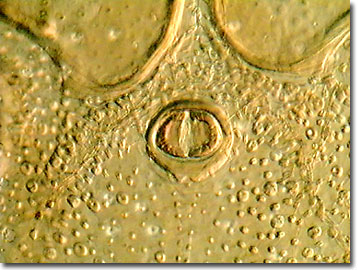Oblique Digital Image Gallery
American Dog Tick Dermacentor variabilis
The American dog tick is often the largest and most common type of tick found in localities across North America. Although it bears the name dog tick, this blood-sucking representative of the arachnids (spiders, tick, and mites) can feed on a wide-variety of mammalian hosts including dogs, coyotes, fox, skunks, cattle, raccoons, opossum, deer, squirrels, rabbits, chipmunks, and when given the opportunity, humans too. Blood meals are required before the parasite can emerge from its larval and nymph stages into adulthood. The digital image presented below is a high magnification oblique illumination view of the tick's hard exoskeleton.

Although American dog ticks are not vectors for Lyme disease, they are the primary carrier of Rocky Mountain spotted fever, a serious threat to human health transmitted by the bacterium Rickettsia rickettsii. As the tick and its host, domestic dogs, have moved across North and Central America into parts of South America, potentially fatal Rocky Mountain spotted fever has followed along. Other diseases associated with American dog ticks are tularemia (rabbit fever), Colorado tick fever, and anaplasmosis. Tick paralysis is also possible when a neurotoxin produced in the tick's ovaries is secreted into the host's blood stream. Known to taxonomists as Dermacentor variabilis, the American dog tick is a member of the hard tick family, Ixodidae.
Dark brown with an irregular pattern of white markings between the main body and the head, mature American dog ticks have eight legs, as do other arachnids. Female ticks use sex pheromones as mate attractants. After the mature, fertilized female has her last blood meal and molts, she drops off the host, lays thousands of eggs in the soil, and then perishes. The hatchling, young six-legged nymphs (or seed ticks) crawl up twigs, weeds, and bushes to wait with open arms for a passing animal, using pheromones for host recognition. Without a host and subsequent blood meals, the questing seed ticks shortly die. The entire life cycle for this ectoparasite takes from three months to more than a year, with a two-year life cycle the norm in more northern states and Canada. While males may be only 0.125 inches in length, while an engorged female may range up to 0.5 inches long.
Contributing Authors
Cynthia D. Kelly, Thomas J. Fellers and Michael W. Davidson - National High Magnetic Field Laboratory, 1800 East Paul Dirac Dr., The Florida State University, Tallahassee, Florida, 32310.
BACK TO THE OBLIQUE IMAGE GALLERY
BACK TO THE DIGITAL IMAGE GALLERIES
Questions or comments? Send us an email.
© 1995-2025 by Michael W. Davidson and The Florida State University. All Rights Reserved. No images, graphics, software, scripts, or applets may be reproduced or used in any manner without permission from the copyright holders. Use of this website means you agree to all of the Legal Terms and Conditions set forth by the owners.
This website is maintained by our
Graphics & Web Programming Team
in collaboration with Optical Microscopy at the
National High Magnetic Field Laboratory.
Last Modification Friday, Nov 13, 2015 at 01:19 PM
Access Count Since September 17, 2002: 14276
Visit the website of our partner in introductory microscopy education:
|
|
